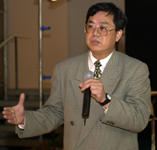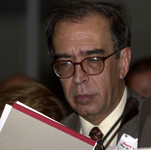 |
|
Highlights from
Thursday, 16 November:
 Delegates
convened in contact groups to discuss text on: mechanisms; capacity
building in countries with economies in transition (EITs); "best
practices" in policies and measures; development and transfer of
technologies; land use, land-use change and forestry (LULUCF); and
guidelines under Protocol Articles 5 (methodological issues), 7
(communication of information) and 8 (review of information). The
Joint Working Group on Compliance (JWG) also met to continue considering
negotiating text. In addition, negotiators met throughout the day
and late into the night in closed "informal informal" consultations
and drafting group meetings to advance negotiations on issues such
as mechanisms, compliance, development and transfer of technologies,
the financial mechanism, adverse effects and capacity building in
developing countries. Delegates
convened in contact groups to discuss text on: mechanisms; capacity
building in countries with economies in transition (EITs); "best
practices" in policies and measures; development and transfer of
technologies; land use, land-use change and forestry (LULUCF); and
guidelines under Protocol Articles 5 (methodological issues), 7
(communication of information) and 8 (review of information). The
Joint Working Group on Compliance (JWG) also met to continue considering
negotiating text. In addition, negotiators met throughout the day
and late into the night in closed "informal informal" consultations
and drafting group meetings to advance negotiations on issues such
as mechanisms, compliance, development and transfer of technologies,
the financial mechanism, adverse effects and capacity building in
developing countries.
Right photo: Mechanisms Chair
Chow Kok Kee (Malaysia)
|
Contact Group: LULUCF
|
 The
Indigenous Peoples Caucus on Climate Change gave a statement
stressing the need to consider indigenous peoples and their needs
and rights on the lands being discussed in the LULUCF contact group,
and condemning the inclusion of sinks under the CDM. The
Indigenous Peoples Caucus on Climate Change gave a statement
stressing the need to consider indigenous peoples and their needs
and rights on the lands being discussed in the LULUCF contact group,
and condemning the inclusion of sinks under the CDM.
|

COLOMBIA
presented their proposal on Expiring Certified Emissions
Reductions (CERs). Noting that permanence is the main problem
related to LULUCF activities, he suggested all LULUCF projects be
treated as potentially non-permanent, and said that associated
CERs should be expired after a specific time period after which
they would be replaced by permanent CERs or new expiring CERs. The
project proponent would be fully liable for the CERs.
|
|
 . .
CANADA said there are solutions to the problem of permanence,
highlighting risk management options.
|
|

Brazil on behalf of the
G-77/CHINA urged no prejudgment on the issue of sinks in the
CDM. He drew attention to the Group's principle on permanence,
underlining that sinks provide temporary removal only.
|
Contact Group: Mechanisms
|
|
The contact group on mechanisms convened at 12:15 pm to receive feedback
from Chair Chow on the closed "informal informal"
discussions that had focused on Article 12 (CDM). Revised text was
circulated on: the role of COP/MOP, the executive board, the
accreditation body, designated operational entities, participation,
financing, monitoring, verification, certification, issuance of CERs,
standards and procedures for the accreditation of operational
entities, a CDM reference manual, and a project design document.
Emphasizing that negotiations need to be completed by midnight on
Friday, 17 November, he urged the group to show leadership in
completing their discussions in a timely manner. Left photo: Mechanisms
Chair Kok Kee Chow (Malaysia) with Eve Kolasa (Secretariat)
|
|